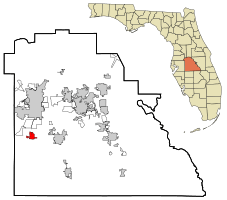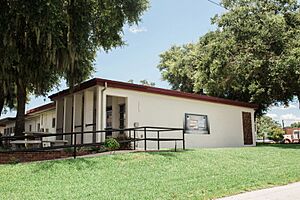Mulberry, Florida facts for kids
Quick facts for kids
Mulberry, Florida
|
||
|---|---|---|
| City of Mulberry | ||

Mulberry City Hall
|
||
|
||
| Motto(s):
"Official Phosphate Capitol of the World"
|
||

Location in Polk County and the state of Florida
|
||
| Country | United States of America | |
| State | Florida | |
| County | Polk | |
| Settled | Circa 1840s | |
| Incorporated | 1901 | |
| Government | ||
| • Type | Commission-Manager | |
| Area | ||
| • Total | 6.88 sq mi (17.83 km2) | |
| • Land | 6.18 sq mi (16.01 km2) | |
| • Water | 0.70 sq mi (1.81 km2) | |
| Elevation | 112 ft (34 m) | |
| Population
(2020)
|
||
| • Total | 3,952 | |
| • Density | 639.17/sq mi (246.79/km2) | |
| Time zone | UTC-5 (Eastern (EST)) | |
| • Summer (DST) | UTC-4 (EDT) | |
| ZIP code |
33860
|
|
| Area code(s) | 863 | |
| FIPS code | 12-47200 | |
| GNIS feature ID | 2404336 | |
Mulberry is a city in Polk County, Florida, United States. It is part of the Lakeland–Winter Haven Metropolitan Statistical Area. The city is located right next to parts of unincorporated Lakeland. In 2020, 3,952 people lived there. Mulberry is also home to the large 334-acre Alafia River Reserve.
Contents
History of Mulberry
The first European settlers arrived in the Mulberry area around the 1840s. At first, the main business was cutting down longleaf yellow pine trees. The settlement slowly grew with log homes, stores, and places to gather. There wasn't much law enforcement nearby, so the town was a bit wild, like scenes from the Old West.
The town didn't have an official name at first. The railroad, which was very important, would stop at a large mulberry tree to let people off and drop off mail. This old mulberry tree became the main meeting spot, and soon everyone started calling the town "Mulberry."
In 1886, a special kind of rock called phosphate rock was found in the nearby Peace River. This discovery changed everything! The main industry switched from cutting trees to mining. The phosphate industry brought stability to the town, and Mulberry officially became a city in 1901. In 1910, a local club called the Masonic lodge was started, and it's still active today.
Geography and Climate
Mulberry is located in the middle of Florida. It's part of the Central Florida Highlands area, which is mostly flat land with some gentle rolling hills.
The city covers a total area of about 6.88 square miles (17.83 square kilometers). Most of this area, about 6.18 square miles (16.01 square kilometers), is land. The rest, about 0.70 square miles (1.81 square kilometers), is water.
You can find Mulberry where two main roads meet: State Road 60 and State Road 37.
Mulberry has a humid subtropical climate. This means it has hot, humid summers and mild, dry winters.
Population Information
| Historical population | |||
|---|---|---|---|
| Census | Pop. | %± | |
| 1910 | 1,418 | — | |
| 1920 | 1,499 | 5.7% | |
| 1930 | 2,029 | 35.4% | |
| 1940 | 1,502 | −26.0% | |
| 1950 | 2,024 | 34.8% | |
| 1960 | 2,922 | 44.4% | |
| 1970 | 2,701 | −7.6% | |
| 1980 | 2,932 | 8.6% | |
| 1990 | 2,988 | 1.9% | |
| 2000 | 3,230 | 8.1% | |
| 2010 | 3,817 | 18.2% | |
| 2020 | 3,952 | 3.5% | |
| U.S. Decennial Census | |||
Population Changes
| Race | Pop 2010 | Pop 2020 | % 2010 | % 2020 |
|---|---|---|---|---|
| White (NH) | 2,703 | 2,474 | 70.81% | 62.60% |
| Black or African American (NH) | 546 | 544 | 14.30% | 13.77% |
| Native American or Alaska Native (NH) | 9 | 10 | 0.24% | 0.25% |
| Asian (NH) | 19 | 21 | 0.50% | 0.53% |
| Pacific Islander or Native Hawaiian (NH) | 1 | 7 | 0.03% | 0.18% |
| Some other race (NH) | 4 | 8 | 0.10% | 0.20% |
| Two or more races/Multiracial (NH) | 47 | 132 | 1.23% | 3.34% |
| Hispanic or Latino (any race) | 488 | 756 | 12.78% | 19.13% |
| Total | 3,817 | 3,952 |
In 2020, the United States Census counted 3,952 people living in Mulberry. There were 1,417 households and 1,020 families.
Back in 2010, the census showed 3,817 people, 1,547 households, and 1,009 families living in the city.
Economy
The economy of Mulberry is mostly focused on mining a mineral called phosphate. The area known as the Bone Valley is famous for having the most productive phosphate rock mines in the world. Because of this, Mulberry is known as the "Official Phosphate Capitol of the World."
The Mosaic Company runs a large mine called Nichols, which is about two miles east of town. Mulberry is also the home of Badcock Home Furniture. Their first store opened in Mulberry in 1904, and now they have 382 stores across the southeastern United States.
Arts and Culture
The Mulberry Cultural Center opened in the fall of 2015. It has hosted more than 25 different art and history exhibits. The center also offers many interesting programs for people of all ages.
In 2018, the Mulberry Murals Initiative was started. Its goal is to bring art to everyone in the community. These public art displays are placed around the city and have been supported by the City of Mulberry.
Transportation
Mulberry has important roads and railway lines.
- State Road 37 goes north towards Lakeland and south towards Bradley Junction.
- State Road 60 goes west towards Brandon and east towards Bartow and Lake Wales.
Mulberry used to be served by two different railroad companies. These lines later joined to become the Seaboard Coastline in 1967, and then became part of the CSX Railroad in 1986. The phosphate industry in the Bone Valley still uses these railroads a lot to move materials.
There's a very unusual spot where two rail lines cross right in the middle of a four-lane highway (State Road 37) near SW 2nd Street.
Education
Public schools in Mulberry are managed by the Polk County School Board. There are three elementary schools in the area: Kingsford, Purcell, and Sikes. For older students, there are Mulberry Middle School and Mulberry High School. Mulberry Christian Academy is a private elementary school that offers financial help to families who need it.
Library
The Mulberry Public Library is part of the Polk County Library Cooperative. You can find it at 905 NE 5th Street, Mulberry, FL 33860. The library offers many resources, including video games, books, DVDs, audiobooks, and digital materials. It also hosts various programs for the community.
Media
Mulberry is part of the Tampa–St. Pete television market. This is one of the largest TV markets in the country. The city is also part of the local Lakeland-Winter Haven radio market.
Sinkholes and the Environment
Mulberry is located in an area where sinkholes can sometimes form. These are holes in the ground that open up when underground rock dissolves.
On June 15, 1994, a sinkhole appeared near Mulberry. It was about 110 feet wide and 200 feet deep. This sinkhole opened up in an area where a material called phosphogypsum was stored. Phosphogypsum is a byproduct from the phosphate fertilizer industry. This material went into underground caves that lead to the Floridan Aquifer, which is a major source of drinking water for many people in Florida.
The company involved, IMC-Agrico (now part of The Mosaic Company), immediately started working to fix the sinkhole. They spent a lot of money to repair the area and protect Florida's water supply.
Later, on August 27, 2016, The Mosaic Company found another large sinkhole under a stack of gypsum. A huge amount of water, which had come into contact with phosphogypsum, went into this new sinkhole. The company has been working to manage and fix this issue as well.
See also
 In Spanish: Mulberry (Florida) para niños
In Spanish: Mulberry (Florida) para niños



